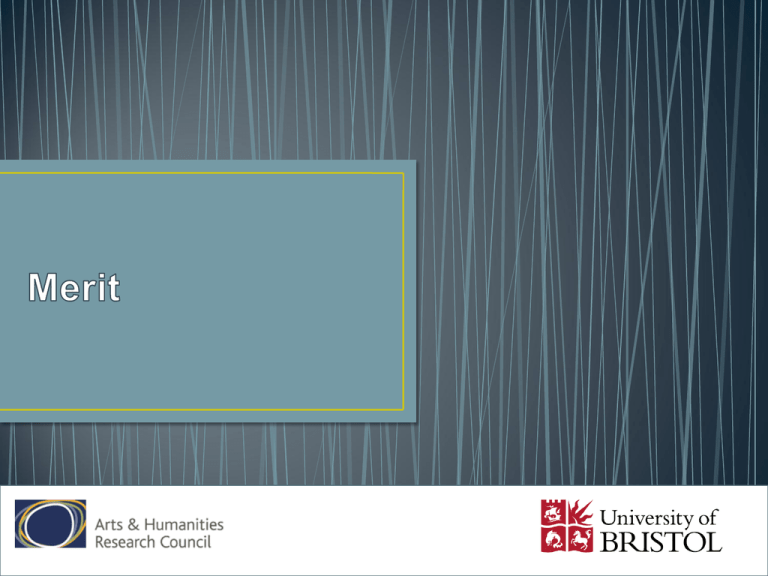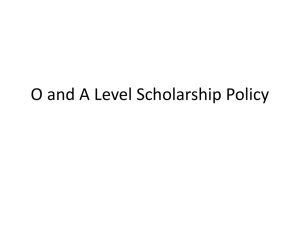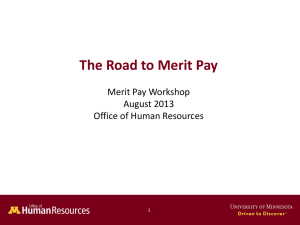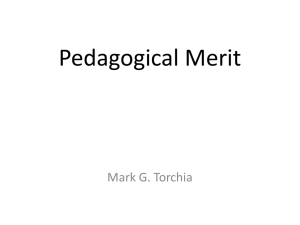Merit Presentation
advertisement

Merit (puṇya/puñña) is an important concept within Buddhist thought. It is what is accumulated through good and wholesome deeds. The production of merit is important as it can have positive effects on the lives of individuals, generate desirable rebirths and also allow one to access higher levels of spiritual attainment. • Merit is essentially good karma. • Karma or kamma can be translated as ‘action’. • In brahmanical society it was initially understood in terms of ritual behaviour. If one performed a certain ritual action it would have a specific result. • Ideas concerning karma evolved and all actions were understood to cause an effect. Actions performed by an individual would cause some sort of effect on the individual in this life, or even in a later life. • In Buddhist thought karma has a causative nature. The actions that are intentionally performed by the individual will have a particular karmic result. Well-intentioned good deeds will result in a pleasant and favourable karmic result whilst malicious and hurtful misdeeds will result in a poor and unfavourable karmic result. • Karma does not always have immediate results, but can take many lifetimes to have an effect. • Positive actions can take a variety of forms. • In the Puññakiriyavatthu Sutta (A IV 146) the Buddha outlines three bases of merit: 1. Generosity- dāna 2. Ethical Conduct- sīla 3. Cultivation/Meditation- bhāvana • Dāna can refer to any act that is performed with an unselfish attitude and positive view of giving. • It is an important aspect of Buddhism as it outlines the relationship that exists between the laity and the monastic community (Saṅgha). • For the laity dāna represents their support of the Saṅgha. • The laity supports the Saṅgha by providing material support such as giving monks food on their alms round, donations of robes and the eight requisites, and money to support the monastery. Monks receiving a gift of new robes at a funeral in Laos (2007). • The Saṅgha receive the gifts of the laity. In doing so they act as a ‘field of merit’. In order to be a field of merit the monk must live by the monastic rules that are set in the vinaya. • The more spiritually advanced the monk is the bigger their field of merit is. This serves to make the monks work towards becoming worthy recipients of the gifts of the laity. • The amount of merit is relative to spiritual advancement and not ordination. • The Saṅgha are also expected to act with generosity. • In return for material support from the laity, the Saṅgha must provide spiritual support. This is achieved through teaching the Dharma/Dhamma to the lay community. • It also means that when invited to give a blessing, chant at funeral or attend a housewarming the Saṅgha is obliged to send a representative. A monk receiving a gift of food from a member of the lay community in Myanmar (2009). • Sīla is a way of acting in a considered ethical manner. • This requires the individual to ensure that they act, think and speak in ways that are positive and conducive to positive mental attitudes. • Sīla is explored within the Eight-fold Path where it is stated that right speech, right action and right livelihood are all forms of acting ethically. Eight Fold Path Grouping Right View Wisdom (prajñā) Right Intention Wisdom (prajñā) Right Speech Ethical Conduct (sīla) Right Action Ethical Conduct (sīla) Right Livelihood Ethical Conduct (sīla) Right Effort Meditation (samādhi) Right Mindfulness Meditation (samādhi) Right Concentration Meditation (samādhi) • Right speech means that one should abstain from gossip, slander and anything that might be considered hurtful. • Right action or conduct requires the individual to act in positive and helpful ways. One should abstain from sexual misconduct, theft and harming others. • Right livelihood means that the individual should not be employed in jobs that cause harm or suffering such as weapons trading and prostitution. One should also be ethical in business by not cheating clients or using underhand methods. • Futher ethical rules for Buddhists are set out in the Five Precepts where they are advised to: 1. Refrain from harming living creatures 2. Refrain from taking what is not given 3. Refrain from sexual misconduct 4. Refrain from false speech 5. Refrain from intoxicants that cause heedlessness. • For those in the laity who want to there are additional precepts that can be followed. These are usually undertaken during special occasions such as full moon festival days: 6. Refrain from eating after midday 7. Refrain from attending entertainments and using perfume 8. Refrain from sleeping on luxurious beds. • Novices follow the Ten Precepts which are an extension of the five or eight precepts that are followed by the laity: 1. Refrain from harming living creatures 2. Refrain from taking what is not given 3. Refrain from sexual activity 4. Refrain from false speech 5. Refrain from intoxicants that cause heedlessness 6. Refrain from eating at the forbidden time 7. Refrain from attending entertainments, singing and dancing 8. Refrain from wearing perfumes, cosmetics and garlands 9. Refrain from sleeping in a high or luxurious bed 10. Refrain from accepting gold or silver In South East Asia it is common for men to ordain as monks for a short period. The man dressed in white is ordaining in memory of a relative in Laos (2007). • For the Saṅgha sīla requires them to live by the monastic codes found within the vinaya. • Different schools of Buddhist thought have different rules in their respective vinayas. Some time after the Buddha died there was a division within the Saṅgha and differing schools of thought were developed. With each school there were differing monastic codes. 1. Prātimokṣa/pāṭimokkha- these are the rules that govern the lives monks and nuns. 2. Regulations covering acts of the Saṅgha as a whole such as performances of chants and ceremonies. • There are, however, four rules that if broken result in the immediate dismissal of a monk or nun: 1. Engaging in sexual intercourse 2. Taking what is not given 3. Taking human life , or persuading someone else to take human life 4. False claims of spiritual attainments. • Bhāvana refers to the cultivation and development of the individual. This can take a number of forms: • citta-bhāvanā- development of the mind (D III. 219) • kāya-bhāvanā- development of the body (D III. 219) • mettā-bhāvanā- development of loving kindness (J I.196) • paññā-bhāvanā- development of wisdom (D III. 219) • samādhi-bhāvanā- development of concentration (A I. 44) For the laity acts of cultivation focus on devotional acts as these cause religious states of mind. This covers: • Worship (pūja) can take the form of prostrationns, circumambulation and the offering of flowers, lamps or incense. • Pilgrimage to holy sites such as Bodh Gaya, Sarnath and Lumbini. Also one can visit any local stūpas and relics. • Creation of images of the Buddha. • Listening to a sermon or Dharma talk. Buddhists can visit stūpas such as the one pictured which is Boudhnath in Nepal. • For the Saṅgha the practice of bhāvana can take several forms: • Devotional practices much like those of the laity including pūja, pilgrimage and the creation of art and Buddha images. • The preservation of texts and scriptures can also fall under this category. • Mediation is perhaps the most recognised form of cultivation employed by the Saṅgha. • Meditation can take the form of recollections (anusmṛti/anussati) of the Buddha, Saṅgha and Dharma. • Recollections can be seen as the basis on ‘calm’ (śamatha/samatha) meditation. This form of meditation stills the mind, it is understood to be a vital tool in developing concentration. • Once one has calmed the mind then they can engage in insight’ (vipaśyanā/vipassanā) meditation. This form of meditation allows the individual to gain insight into the true nature of reality. • This list only covers some of the ways in which monks can develop themselves. There are many other methods that can be found in sources such as the Visuddhimagga. This statue of a corpse is used by monks as a tool for meditation as it makes them reflect on the nature of life and reality (Myanmar, 2009). • The three bases of merit are not the only list of actions that are conducive to the production of merit. • In the Abhidhammattha Saṅgaha there is a list of ten actions that are considered to be meritorious. They are closely related with the three bases of merit with each of the ten actions falling under the remit of one of the bases. • • • • • • • • • • 1. Generosity (dāna) 2. Morality (sīla) 3. Meditation (bhāvana) 4. Reverence (pacāyana) 5. Service (veyyāvacca) 6. Transference of merit (pattidāna) 7. Rejoicing in (other’s) merit (pattanumodāna) 8. Hearing the Doctrine (dhamma-savana) 9. Teaching the Doctrine (dhamma-desanā) 10. Straightening one’s views (diṭṭhijjukammavasa) A Comprehensive Manual of Abhidhamma: The Abhidhammattha Saṅgaha of Ācariya Anuruddha, ed. Bhikkhu Bodhi and Mahāthera Nārada (Buddhist Publication Society: Kandy, 2007), p. 209. • The giving of merit, often referred to as the ‘transfer’ or ‘transferral’ of merit (pattidāna), is an important part of Buddhist practice and it forms a major part of modern Buddhist practice. • When an individual has generated merit they can decide to give the merit away. Merit is typically given to a deceased relative, to gods, or to all sentient beings. • Merit can only be generated if the individual wants to help others. Positive acts that are motivated by selfishness and desire will not produce merit. • Although it appears that merit can be transferred this is not the case. Technically nothing is given away, merit is only ‘given’ when the intended recipient ‘rejoices’ in the merit generated by the donor. It is through this rejoicing that the recipient generates their own merit. • An example of the transferral can be found in the ritual known as ‘the offering of cloth on behalf of the dead’ (mataka-vastra-puja) which is performed at Theravāda funerals. • Before a funeral monks are offered a white cloth which is intended to be used to make monastic robes. During this ceremony, the following verse which was, according to the Mahaparinibbana Sutta, spoken by god Sakka after the passing away of the Buddha, is recited: Formations truly they are transient, It is their nature to arise and cease, Having arisen, then they pass away, Their calming and cessation—happiness. Water is then poured into an overflowing cup to represent the transfer of merit whilst the following is chanted: Just as water rained on high ground moves [down] to the low land, even so does what is given here benefit the dead. Just as the rivers full of water fill the ocean full, even so does what is given here benefit the dead. The following verses have been translated for this document, or have been adapted from ‘The Mirror of the Dhamma’ which can be found at www.bps.lk/olib/wh/wh054.pdf Monks in Sri Lanka (1999) pouring water whilst chanting Pali verses. • Merit can also be gained through witnessing the meritorious deeds of others. If an individual witnesses a good deed and is pleasantly struck by the generosity of the act they too will receive merit. • It is customary at the end of Buddhist ceremonies or donations to see merit transferred to others. This act allows all present to rejoice in the merit and therefore become recipients of merit.








